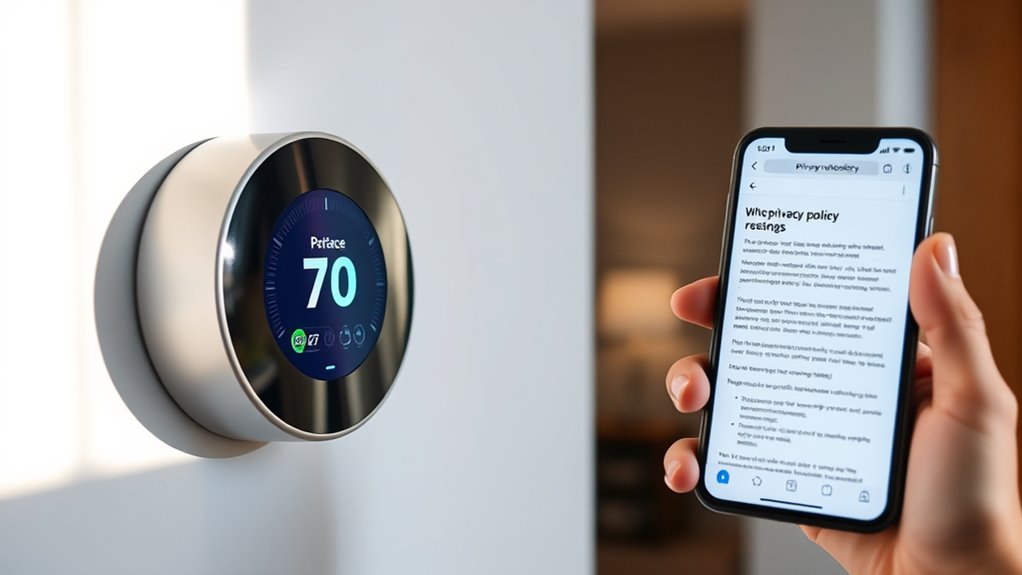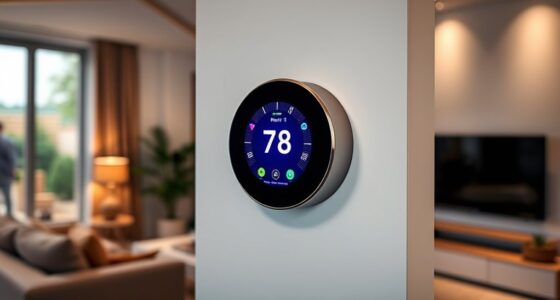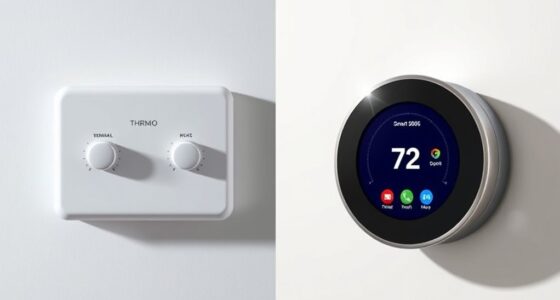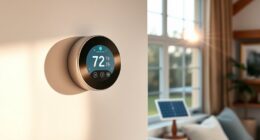To compare smart thermostat privacy policies, focus on how each company encrypts your data during transmission and storage, and whether they share information with third parties. Look for clear details about what data they collect, how long they keep it, and if you have options to opt out of sharing. Transparency and security measures matter. If you continue exploring, you’ll discover more tips to help you make an informed choice.
Key Takeaways
- Review the privacy policy to understand what data is collected and for what purpose.
- Check if the company employs strong encryption and security measures to protect your data.
- Verify whether the company shares data with third parties and if opt-out options are provided.
- Assess the transparency of data storage duration, user rights, and policy update practices.
- Compare the level of detail and clarity in privacy policies to ensure informed privacy choices.

When choosing a smart thermostat, understanding how companies handle your data is essential. Privacy policies vary widely, and knowing what happens to your information can help you make an informed decision. One key aspect to look for is how your data is protected during transmission and storage. Data encryption is a vital feature, ensuring that your personal information, including usage patterns and location data, is scrambled and unreadable to outsiders. If a company emphasizes robust data encryption measures, it indicates a commitment to safeguarding your privacy. Conversely, if a policy lacks mention of encryption practices, your data might be vulnerable to interception or breaches. Additionally, some companies incorporate predictive analytics to improve device functionality, which may involve analyzing your usage data—so understanding how this is managed is also important. Another important factor to consider is how your data might be shared with third parties. Some companies explicitly state that they do not share user data, while others may collaborate with third-party advertisers, analytics providers, or service partners. If third party sharing is disclosed, you should check who these entities are and what they might do with your data. For example, some companies share anonymized data for research or product improvement, which might be less intrusive. However, sharing identifiable information or selling data to marketers can raise privacy concerns. Carefully review the policy to see if you have control over such sharing, for example, through opt-out options. Beyond encryption and third-party sharing, assess how transparent the privacy policy is about data collection practices. Does the company specify what data they collect and why? Are there clear explanations about how long your data is stored and what rights you have regarding its deletion or correction? The more detailed the policy, the better you can understand what you’re agreeing to. Also, check if the policy mentions security measures beyond encryption, like access controls or regular audits, which demonstrate a company’s dedication to protecting your information. Finally, consider whether the company updates its privacy policy regularly and how it communicates changes. Laws and technologies evolve, so a good policy should be updated to reflect current practices, and you should be notified of significant changes. Comparing these aspects across different brands helps you choose a smart thermostat that aligns with your privacy expectations. Prioritizing companies that use strong data encryption, limit third party sharing, and maintain transparency can give you peace of mind, knowing your personal data is handled responsibly.
Frequently Asked Questions
How Often Do Companies Update Their Privacy Policies?
Companies typically update their privacy policies annually or when new data practices are introduced. You should regularly check for updates to stay informed about changes that might affect your user consent and data encryption. Updates often include clarifications on how your data is protected and used. By reviewing these policies periodically, you ensure you’re aware of your rights and how your personal information is handled, especially regarding data encryption and privacy safeguards.
Do Smart Thermostats Share Data With Third-Party Advertisers?
You might feel cozy knowing your thermostat keeps your home comfortable, but it could also be unsettling to learn it shares data with third-party advertisers. Many smart thermostats do engage in data sharing for third-party advertising, which means your energy usage and habits could be used to target ads. Always review privacy policies to understand how your data is being shared and consider opting out if you want more control.
Are User Data Anonymized in Privacy Reports?
You’ll find that user data in privacy reports is often anonymized to protect your identity. Companies typically use data encryption to secure your information and rely on user consent before sharing any details. It’s important to review privacy policies carefully, so you understand how your data is anonymized and whether your consent is required for specific data uses. Always stay informed to make the best privacy choices.
What Rights Do Consumers Have to Access Their Data?
You have the right to access your data under data ownership laws, meaning you can request copies of your information stored by your smart thermostat provider. They must obtain your user consent before collecting or sharing your data, and you can usually review, correct, or delete your data if you wish. Always check the company’s privacy policy to understand your specific rights and how they handle your data.
How Is Data Breach Information Communicated to Users?
When a data breach occurs, the company typically issues a data breach notification directly to you, often via email or app alerts. They should explain what happened, what data was affected, and how they’re addressing it. Your user consent is vital, so make sure you’ve authorized notifications and understand your rights. Stay vigilant and review the company’s privacy policy to know how they handle data breach communications.
Conclusion
By examining each smart thermostat’s privacy policy, you reveal their true intentions behind your data—like peeling back layers of an onion. Remember, transparency isn’t just a promise; it’s your shield. As you compare, stay vigilant and question what’s beneath the surface. Ultimately, choosing a device with a clear, respectful privacy stance isn’t just smart—it’s essential, turning the silent guardian of your home into a trusted partner you can truly rely on.









